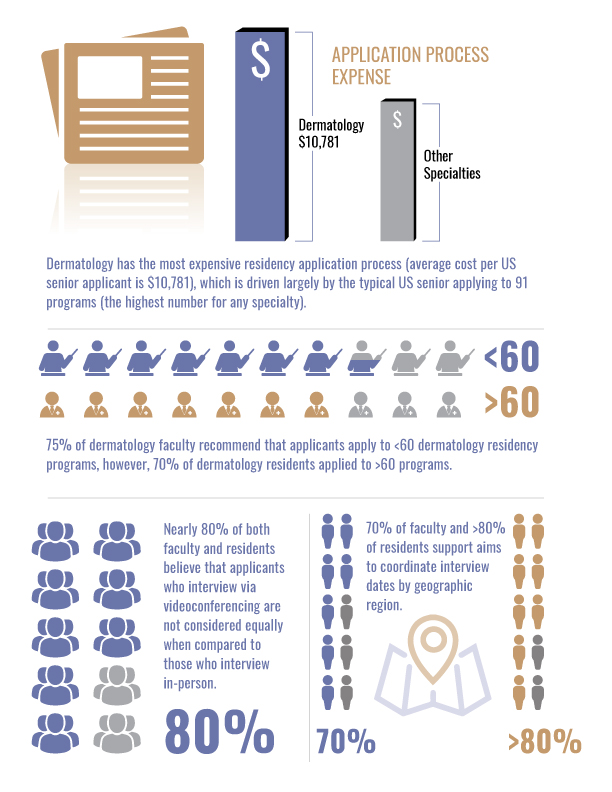The way we select the future generation of dermatologists is overdue for an overhaul.
Having just recently completed my residency at Oregon Health & Science University, I am still able to vividly recall the stress-inducing and bank-breaking experience of applying to dermatology. It’s no secret that getting into dermatology is very competitive, so I was told by several mentors to apply to/interview at as many programs as possible to maximize my chances of successfully matching. Translation: you will need to spend thousands of dollars in order to land your dream job…and, oh yeah, there’s a decent chance you won’t match and you’ll have to scramble into a different specialty altogether.It’s Time to Rethink the Current Dermatology Residency Application Process
Coming from a very modest background, I was only able to attend college and medical school because of student loans and scholarships, so I seriously questioned whether or not I could afford such a gamble. Ultimately, I decided that my passion for dermatology was worth the risk, so I added ~$10,000 in student-loan debt at the beginning of my 4thyear of med school to cover the cost of away rotations, application fees (to over 100 programs), and interviewing all over the country.
Identifying the key issues and potential modifications
As I’ve come to learn, my experience represents the norm: dermatology has the most expensive residency application process (average cost per US senior applicant is $10,781), which is driven largely by the typical US senior applying to 91 programs (the highest number for any specialty).1-3Fortunately I matched at OHSU (I was one of the lucky ones), but I couldn’t shake the feeling that there had to be a more efficient, less expensive way to enter this specialty. As a result, I recently worked with the residency directors at OHSU (Dr. Nicole Fett) and UCSF (Dr. Kanade Shinkai) to survey dermatology faculty and residents’ perspectives about the application process, and identify potential modifications that are widely supported and, thus, likely to be implemented in the future.4
What story does the survey data tell?
We had a great response rate, with 174 residents and 180 faculty members completing the survey. Here are the highlights of our findings:
- ~75% of dermatology faculty recommend that applicants apply to <60 dermatology residency programs
- >70% of dermatology residents applied to >60 programs
- Nearly 80% of both faculty and residents believe that applicants who interview via videoconferencing are not considered equally when compared to those who interview in-person
- 70% of faculty and >80% of residents support aims to coordinate interview dates by geographic region
- ~75% of faculty are willing to work with other programs to implement interview coordination
Our nationwide survey has several important implications. First, the significant discordance between the high rate at which residents (i.e. recent applicants) applied to >60 programs despite the majority of faculty recommending applying to <60 programs likely reflects perceptions about the highly competitive nature of matching into dermatology. Recent AAMC data indicate that there is minimal additive benefit of applying to >40 programs with respect to the outcome of matching into dermatology.5I have incorporated this data when advising medical students in order to reduce this gap and application costs, and other faculty should do so as well.
Second, the majority of both faculty and residents believe that applicants who interview via videoconferencing are not considered equally to those who interview in-person. This calls into question the utility of offering videoconference interviews as an alternative to limit applicants’ expenses.6 Residents and faculty support the coordination of interview dates by geographic region. Because of this, most faculty are willing to work with other programs to implement this change. The coordination of interviews represents a realistic opportunity to: 1) lessen applicants’ expenses and stress associated with frequent travel; 2) limit programs from offering conflicting interview dates; 3) reduce interview cancellations due to weather/transportation issues/etc; 4) decrease applicants’ carbon-footprint.
Our study also suggests that the current dermatology residency application process, with its exorbitantly high cost, disadvantages applicants from lower socioeconomic backgrounds and/or is a barrier to applying to dermatology. Dermatology is also one of the least diverse specialties, second only to orthopedic surgery5. Because of this, it should be an explicit aim of our specialty to promote inclusivity. Future qualitative studies will be important to better understand the perspectives of dermatology applicants and to identify strategies for both applicants and residency programs to lower costs and remove barriers to the application process.
Income inequality in America continues to grow, and the medical profession is not immune to its effects. Dermatology, in particular, is at high risk of becoming a specialty comprised of physicians that do not come close to representing the socio-economic diversity of the patients in this country. It is critical that those of us in the dermatology community make the necessary changes to attract the most promising medical students from all walks of life; otherwise we risk alienating the people we’ve vowed to help.
References:
- Mansouri B et al. The cost of applying to dermatology residency: 2014 data estimates. JAAD. 2016; 74(4): 754-6.
- Polacco MA et al. Digging into debt: the financial burden associated with the otolaryngology match. Otolaryngol Head Neck Surg. 2017; 156(6): 1091-6.
- National Resident Matching Program. Results of the 2017 NRMP Applicant Survey. Washington, DC: National Resident Matching Program; 2017. Available at: URL: http://www.nrmp.org/wp-content/uploads/2017/09/Applicant-Survey-Report-2017.pdfAccessed November 3, 2017.
- Rojek NW et al. Dermatology faculty and residents’ perspectives on the dermatology residency application process: a nationwide survey. JAAD. 2018; 79(1): 157-159.
- Association of American Medical Colleges. Apply smart in dermatology: new data to consider. Available at: URL: https://www.aamc.org/cim/481320/applysmartderm.htmlAccessed November 3, 2017.
- Chen A, Shinkai K. Rethinking How We Select Dermatology Applicants—Turning the Tide. JAMA Dermatol. 2017; 153(3): 259-260.
Did you enjoy this post? Find other articles on Navigating Your Career by clicking here.

